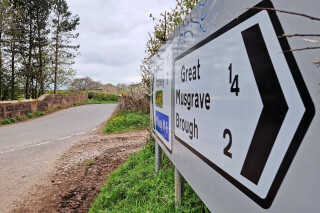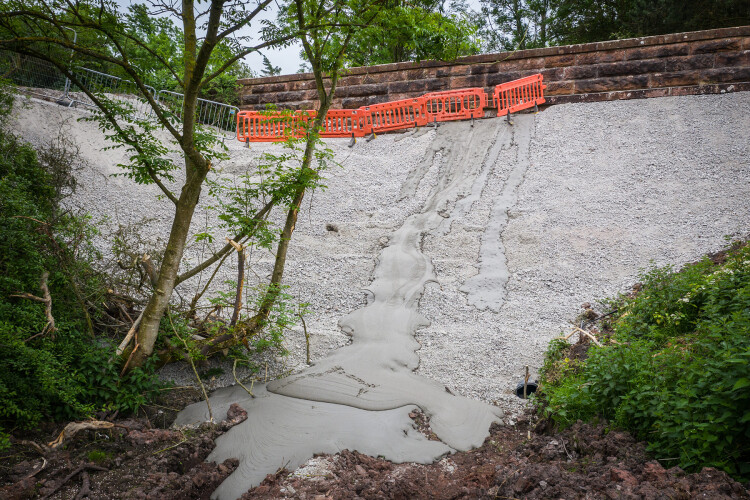National Highways filled the arch over the disused railway at Great Musgrave in Cumbria with thousands of tonnes of concrete under emergency permitted development rights in 2021.
The bridge, which was not in a dangerous condition, is an 8.45-metre single span, sandstone masonry arch bridge constructed in 1862 to carry the B6259 over the former Eden Valley Railway. The action put an end to hopes of linking the Eden Valley and Stainmore railways to create an 11-mile tourist line between Appleby and Kirkby Stephen.
As custodian of the Historical Railways Estate, National Highways is responsible for 3,100 disused structures on behalf of the Department for Transport. It attracted fierce criticism in 2021 after it emerged that dozens of its bridges and tunnels had been earmarked for demolition or infilling as part of an asset management programme despite many of them being needed for proposed cycle routes, reopened railways or heritage line extensions.
After an outcry led by the HRE Group, which campaigns to protect the Historic Railways Estate, National Highways was forced to submit a retrospective planning application to retain the infill material at Great Musgrave. But this was rejected by Eden District Council in June last year, after which an enforcement notice was issued requiring its removal by 11 October 2023.
Contractor Amco Giffen has already carried out preparatory works to expose the top part of the bridge’s north side, but the main scheme, due to start on 17th July, involves excavating beneath the bridge’s arch. National Highways has arranged a closure of the B6259, which crosses the bridge, for the three-month duration of the project “so our colleagues can work safely”, according to its website.
According to the HRE Group “it is not expected that workers will be on-site throughout that period”.
According to the campaigners there was no consultation with either the heritage railways or the parish council before infilling took place and locals remained in the dark about the road closure until signs appeared last week.

Tim Wells, who chairs Musgrave Parish Council, said: “It’s absolutely ridiculous – have they learned nothing? Yet again, there’s been no dialogue with the community directly affected by their actions. How can National Highways not understand the impact this closure will have on villages served by this crucial road?
“Several farms have property on both sides of the bridge - they need to use it every day. There’s a produce seller who will lose most of their passing trade. Are they going to be compensated? The school bus won’t be able to cross, so what are the children going to do? And then there are people who need to get to work and do their shopping.
“The bridge is about 30 yards long. If you’re in a small vehicle that can use the lane heading north from Great Musgrave, the diversion from one end of the bridge to the other is almost five miles. But for a bigger farm machine, at best you’re looking at more than seven miles going via Brough, and that assumes it will fit under the low bridge at Warcop.
“What they’re planning to impose is unacceptable.”

In response to the latest outcry, National Highways said: “This work is a delicate process and our contractor has developed a methodology to carry these works out in a safe way, both for their team and to conserve the bridge arch.
“We can understand that having the road closures in place overnight outside of the working hours of 8am until 6pm might seem unnecessary but the bridge cannot be used safely once work has begun.
“Workers will be on site throughout the 13-week period of closures. During the first week, initial work will take place to prepare the area and ensure the safety of the site for the workforce. Coring will then begin on the second week of closures and this is when people will begin to see more of the workforce on site.”
The HRE Group, comprising engineers, greenway developers and sustainable transport advocates, has been leading the campaign against National Highways’ infilling and demolition of legacy railway structures.
The government stepped in to halt the programme after the Great Musgrave scheme was derided as cultural vandalism, but six infill projects and one demolition form part of the company’s provisional works programme for this financial year, subject to ministerial approval and, in most cases, planning permission.

Graeme Bickerdike, a member of the HRE Group, said: “National Highways has been taking positive steps in a better direction over the past 18 months, but they still seem to lack good judgement and fail to understand the importance of early, effective engagement with those impacted by their work.
“The frustration being expressed around Great Musgrave is understandable. National Highways cannot upset community life for such a prolonged period whilst they put right a mistake they shouldn’t have made in the first place. They describe infilling as ‘fully reversible’, but clearly not without huge disruption and the deepest of pockets.
“We understood there would be a stand-down period between the removal of the infill – or at least part of it – and any strengthening work, being undertaken, during which time the bridge’s capacity would be reassessed, a scheme design produced and the work planned and resourced.
“There has to be a way of appropriately ensuring the safety of their contractor’s workforce whilst recognising the needs of local people to go about their business. Continued access across the bridge, with careful traffic management, is clearly vital.”
Meanwhile, 280 people have objected to National Highways’ retrospective planning application to retain infill at another historic railway bridge, at Congham in Norfolk. Emergency permitted development rights were again used, but the local planning authority intervened because the material had not been removed within the maximum permitted period of 12 months.
Got a story? Email news@theconstructionindex.co.uk



